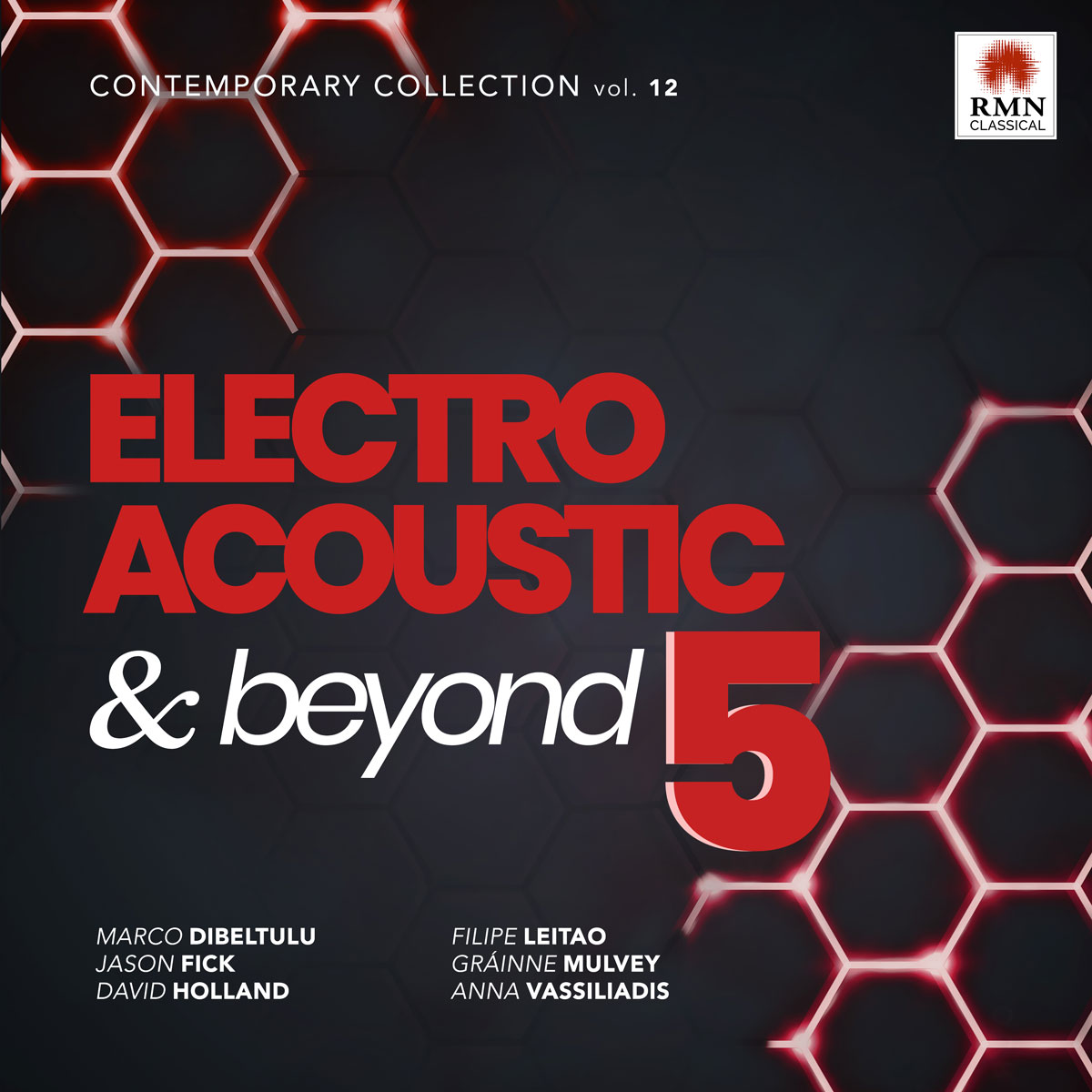MUSIC > Electroacoustic & Beyond 5

FULL ALBUM
Title: Electroacoustic & Beyond 5
Release Date: 3 Jun 2020
Label: RMN Classical
Produced by R. Romano
Cover design by RMN Classical
Electroacoustic & Beyond 5 by Various Artists
| N. | Play | Title | Composer | Time |
| 01 | Quadri degli elementi | Marco Dibeltulu | 09:02 | |
| 02 | Junktures | Jason Fick | 06:43 | |
| 03 | First Rituals | David Holland | 08:53 | |
| 04 | Isaac’s World | Filipe Leitao | 08:05 | |
| 05 | Religious Transformations | Anna Vassiliadis | 05:42 | |
| 06 | The Shoulder | Gráinne Mulvey | 05:18 |
Quadri fegli Elementi commissioned by Amici della Musica di Cagliari, has a didactic purpose and is divided into four different parts inspired by air, water, earth and fire. The four elements are associated to instrumental sections and different musical genres. Each section is made up of two different parts: one is the natural sounds recorded in the framework of the project “Erasmus Plus - The soundscape we live in”, the other is the sounds produced by musical instruments played by some students of the Liceo Musicale “D. A. Azuni” of Sassari (Samuele Cossu, Gabriele Fais, Fabio Foddai, Federico Pintus, Nicola Roggio and Enrico Serra), who improvised according to their own sensibility.
The first section, a tribute to neoclassicism, is dedicated to the sounds of air. We can distinguish the verses of seagulls and various birds that contrast with the melodic lines of wind instruments. The second section is about the water element, and is associated to the percussion instruments. It has an atonal character and uses a contemporary language. Here we can find imitations between synthetic sound objects and the sound of water. The third section is associated to the voice. The protagonist is humanity, its culture and its popular tradition. Natural sounds introduce a summer soundscape, but soon two Sardinian choirs, the “Coro Gabriel” of Tempio Pausania and the choir “Cuncordu Lussurzesu” of Santu Lussurgiu, lead the listener to a mystical atmosphere. The last section combines the sounds of a fire with those of the string instruments. The great density of the final, with fireworks and pizzicato gradually replacing the crackling of flames, represents the strength of fire as a constitutive element of the universe.
The first section, a tribute to neoclassicism, is dedicated to the sounds of air. We can distinguish the verses of seagulls and various birds that contrast with the melodic lines of wind instruments. The second section is about the water element, and is associated to the percussion instruments. It has an atonal character and uses a contemporary language. Here we can find imitations between synthetic sound objects and the sound of water. The third section is associated to the voice. The protagonist is humanity, its culture and its popular tradition. Natural sounds introduce a summer soundscape, but soon two Sardinian choirs, the “Coro Gabriel” of Tempio Pausania and the choir “Cuncordu Lussurzesu” of Santu Lussurgiu, lead the listener to a mystical atmosphere. The last section combines the sounds of a fire with those of the string instruments. The great density of the final, with fireworks and pizzicato gradually replacing the crackling of flames, represents the strength of fire as a constitutive element of the universe.
Junktures offers the listener an elaborate narrative based on the momentary world of sudden impact, while alluding to the sensations of autonomous sensory meridian response (ASMR). Illuminating and extending the sounds of bending, ripping, and breaking, this work was realized through juxtaposing unprocessed and synthesized versions of the original source material in an attempt to explore pivotal moments in time and the connections between them that forge new pathways.
First rituals is a work through which the composer explores the relationship between the sounds of ordinary or ‘miscellaneous’ rituals and routines (represented by objects such as pans and a wine bottle) and ‘sacred’ rituals (represented by objects such as a prayer bowl). The work was led by a question: "How these everyday sounds can transcend their origins to suggest associations with rituals that carry more meaning or significance?" At times these sounds move towards purity, harmony and even the suggestion of voice, while at others they become layered, noisy textures that circle and envelope the space.
Isaac’s World is an electronic piece featuring audio samples of the composer's son, Isaac, a three-year old, Brazilian and American kid who speaks both Portuguese and English. The work tries to capture and musically evoke a child’s sense of personal experience, growth, and development, using Isaac’s diverse vocal sounds, including English and Portuguese words spoken by Isaac.
Much like a timeline, the composition unfolds chronologically, with each of its three sections representing individual stages of Isaac’s life. The first represents his life in the womb; the second goes from birth to the time his first words were spoken; the third and final section focuses on the time from when Isaac learned to speak to the present.
Much like a timeline, the composition unfolds chronologically, with each of its three sections representing individual stages of Isaac’s life. The first represents his life in the womb; the second goes from birth to the time his first words were spoken; the third and final section focuses on the time from when Isaac learned to speak to the present.
Religious Transformation is based on recordings made in Greek orthodox churches and in particular during the sacraments of wedding and baptism. The main components of the composition are the priests' psalms, surrounded by dozens of other processed sounds, aimed at transporting the listener into a world of devotion (and illusion). The psalms’ were recorded live during sacraments, while the rest of the work was built exclusively in a digital environment.
The underlying theme of the work is the beginning of a new life, which led the composer's choice of material. The wedding as a sign of a new beginning for a couple, the baptism as a symbolic beginning of an infant’s life. The composition provides a microstructure of assorted feelings representing the various moments of happiness, fear and agony, interlaced by others evoking joy or peace.
The underlying theme of the work is the beginning of a new life, which led the composer's choice of material. The wedding as a sign of a new beginning for a couple, the baptism as a symbolic beginning of an infant’s life. The composition provides a microstructure of assorted feelings representing the various moments of happiness, fear and agony, interlaced by others evoking joy or peace.
The Shoulder is a movement from the work titled A Carlow Song Cycle and is the brainchild of the Carlow poet, Derek Coyle and guitarist Morgan Buckley, who commissioned the piece. The work centres on the poetry of Derek Coyle, based on the environment and location of Carlow, Ireland, his childhood and experiences of growing up within the greater global community and is now a recently published book called Reading John Ashbury in Costa Coffee Carlow.
The full work, written for soprano and guitar, has six short movements in total, lasting approximately 25 minutes and has an electronic movement with the poet reading one of his works - The Shoulder - where he muses about one of Kafka’s partners, Milena Jesenská. It lasts five minutes and uses the voice of the poet and the singer, soprano Elizabeth Hilliard, underpinned by guitar sounds synthesised.
The full work, written for soprano and guitar, has six short movements in total, lasting approximately 25 minutes and has an electronic movement with the poet reading one of his works - The Shoulder - where he muses about one of Kafka’s partners, Milena Jesenská. It lasts five minutes and uses the voice of the poet and the singer, soprano Elizabeth Hilliard, underpinned by guitar sounds synthesised.

